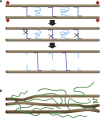Cell wall mechanics and growth control in plants: the role of pectins revisited
- PMID: 22685449
- PMCID: PMC3368173
- DOI: 10.3389/fpls.2012.00121
Cell wall mechanics and growth control in plants: the role of pectins revisited
Abstract
How is the extensibility of growing plant cell walls regulated? In the past, most studies have focused on the role of the cellulose/xyloglucan network and the enigmatic wall-loosening agents expansins. Here we review first how in the closest relatives of the land plants, the Charophycean algae, cell wall synthesis is coupled to cell wall extensibility by a chemical Ca(2+)-exchange mechanism between Ca(2+)-pectate complexes. We next discuss evidence for the existence in terrestrial plants of a similar "primitive" Ca(2+)-pectate-based growth control mechanism in parallel to the more recent, land plant-specific, expansin-dependent process.
Keywords: Chara corallina; pectin; pectin methylesterase; wall extensibility.
Figures


References
-
- Boyer J. S. (2009). Cell wall biosynthesis and the molecular mechanism of plant enlargement. Funct. Plant Biol. 36 383–394 - PubMed
-
- Caesar K., Elgass K., Chen Z., Huppenberger P., Witthoft J., Schleifenbaum F., Blatt M. R., Oecking C., Harter K. (2011). A fast brassinolide-regulated response pathway in the plasma membrane of Arabidopsis thaliana. Plant J. 66 528–540 - PubMed
-
- Carpita N., McCann M. (2000). “The cell wall,” in Biochemistry and Molecular Biology of Plants, eds Buchanan B., Gruissem W., Jones R. (Rockville, MD: American Society of Plant Physiologists; ), 52–108
-
- Cavalier D. M., Lerouxel O., Neumetzler L., Yamauchi K., Reinecke A., Freshour G., Zabotina O. A., Hahn M. G., Burgert I., Pauly M., Raikhel N. V., Keegstra K. (2008). Disrupting two Arabidopsis thaliana xylosyltransferase genes results in plants deficient in xyloglucan, a major primary cell wall component. Plant Cell 20 1519–1537 - PMC - PubMed
LinkOut - more resources
Full Text Sources
Other Literature Sources
Miscellaneous

